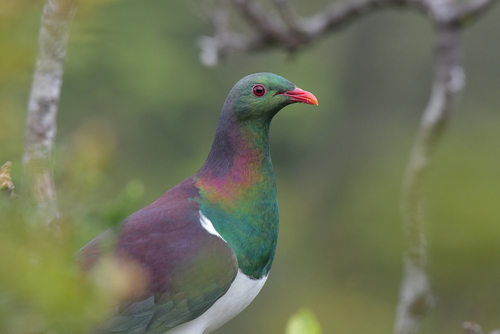
New Zealand Pigeon
The New Zealand Pigeon, also known as Kererū (in Māori), or Kūkū/Kūkupa in some dialects, is a large, striking bird endemic to New Zealand. It plays a crucial ecological role as one of the few native species capable of dispersing the large seeds of native trees like karaka and tawa. This makes it a keystone species in New Zealand's forests. Culturally, the Kererū is significant to Māori, traditionally used as a food source and its feathers for ceremonial cloaks. However, hunting is now illegal, and conservation efforts focus on protecting this iconic bird.
45-50 cm
Length
70-75 cm
Wingspan
Least Concern
Conservation Status
Distribution
Endemic to New Zealand, found on the North, South, and Stewart Islands, as well as several offshore islands. Historically widespread, its range has contracted due to habitat loss and predation.
Lifespan
Up to 15-20 years in the wild, potentially longer in captivity (though specific data is limited).
New Zealand Pigeon's Habitat
Habitat Types
Native forests, Shrublands, Rural gardens, Urban parks
Climate Zones
Temperate, Subtropical
Adaptations
Their broad wings and relatively large size allow them to navigate dense forest canopies and carry large fruits.
Variations
Two subspecies are generally recognized: *H. n. novaeseelandiae* (found throughout most of New Zealand) and *H. n. chathamensis* (the Chatham Island Pigeon, which is larger and has a slightly different plumage). A third, *H. n. spadicea*, from Norfolk Island went extinct in the early 1900s.
Appearance
Breeding Plumage
No significant difference between breeding and non-breeding plumage.
Seasonal Feather Changes
Minimal seasonal variation.
Sex Based Plumage Differences
Males and females have similar plumage. The upperparts are iridescent green-purple, with a bronze sheen. The breast is white, sharply contrasting with the darker head and back. The bill is red with an orange tip, and the eyes and feet are red.
Notable Features
Large size compared to other pigeons., Distinctive iridescent green-purple plumage., Loud, whooshing wingbeats in flight.
Diet and Feeding
Primary Foods
Fruits, Leaves, Flowers, Buds
Foraging Behavior
Primarily arboreal, feeding in trees. They are known for their ability to swallow large fruits whole. They also browse on leaves and buds, sometimes hanging upside down to reach them.
Specializations
Their digestive system is adapted to handle large fruits and extract nutrients efficiently. They are one of the few birds able to disperse the large seeds of many native New Zealand trees.
Seasonal Diet Variations
Their diet varies seasonally depending on the availability of fruits, flowers, and leaves. They may consume more leaves when fruits are scarce.
Behavior
Social Structure
Generally solitary or seen in pairs, but may congregate in small groups at abundant food sources.
Communication
Soft cooing vocalizations., Loud, whooshing wingbeats used in displays and communication., Bowing displays
Migration
Non-migratory, but may make local movements in response to food availability.
Territorial or Group Behaviors
Not strongly territorial, but may defend a feeding tree from other birds.
Conservation
Threats
Habitat loss (deforestation), Predation by introduced mammals (rats, stoats, possums), Illegal hunting (historically a major threat), Competition with introduced species for food
Protection Programs
Predator control programs in key areas., Habitat restoration projects., Legal protection from hunting., Community education and awareness programs.
Local National Laws
Fully protected under the Wildlife Act 1953 in New Zealand. Hunting is illegal.
Population Trend
Stable
Population Estimates
Population estimates are not clearly defined, but the species is considered relatively common in areas with suitable habitat and predator control.
Interesting Facts
Kererū are known for their 'drunk' behavior.
They sometimes eat fermented fruits, which can lead to them becoming intoxicated and exhibiting erratic behavior.
They are the only seed disperser for some large-fruited native trees.
This makes them vital for the regeneration of these trees and the overall health of New Zealand's forests.
The Chatham Island Pigeon is significantly larger than the mainland subspecies.
This is an example of island gigantism, where isolated populations evolve to be larger than their mainland relatives.
The sound of their wingbeats is very distinctive.
The 'whoosh' sound is easily recognizable and often the first indication of a Kererū's presence.
Faqs about New Zealand Pigeon
Are Kererū endangered?
No, Kererū are currently classified as 'Least Concern' by the IUCN, but they are still fully protected in New Zealand due to past population declines and ongoing threats.
What can I do to help Kererū?
Support conservation efforts by planting native trees, controlling predators in your area (if applicable), and reporting any sightings of injured or dead Kererū to the Department of Conservation.
Can I feed Kererū?
It's generally best not to feed Kererū directly, as this can make them dependent on humans and alter their natural foraging behavior. Providing a source of clean water, especially during dry periods, is a better way to help.
What is 'crop milk'?
Crop milk is a nutritious secretion produced by both male and female pigeons and doves. It's rich in protein and fat and is fed to young chicks for the first few days of their lives.
Copyright @ Nature Style Limited. All Rights Reserved.
 English
English